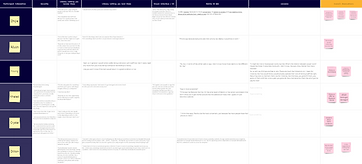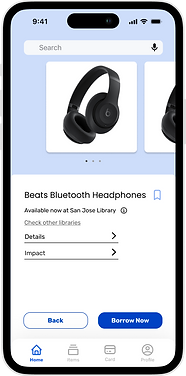
Overview
The Challenge:
Overconsumption is a pervasive issue as a result of capitalism. Especially in the digital age, convenience of online shopping has led to users purchasing items that may only be used once or twice.
This same digital age has resulted in the decline of in-person library use, increasing their idling capacity of building space.
According to the Institute for Museum and Library Services' Public Library Survey (PLS), there was a 28% decline of library use in American from 2009 to 2019.

When you go to the library and borrow a book, you’re likely borrowing it because you don’t want to buy it.
So, what if we did this with regular items?
The Design Solution:
To create a product that partners with local libraries with idling capacity to store and distribute items lent by residents..
People would either submit a drop off request for an item or check availability and hold an item through the app. The product would aim to alleviate idling capacity and give publicly funded libraries a new and reinvented use.
Discovery
We asked San Francisco Bay Area residents...
"On a scale from 1 to 5, how much do you agree with the following statements?"
"I have too many things"

"It is difficult for me to get rid of something I don't use anymore"

KEY SURVEY FINDINGS -
-
68.8% of users feel that they have too many things
-
78.1% of users find it difficult to get rid of their unused items
To gain a deeper understanding of Bay Area residents and their tendencies to buy and accumulate items, we conducted interviews.
In these interviews, we gauged residents' library usage and their likelihood of using one to borrow and lend items.
Click a Miro board to view our thematic map of the interview findings
KEY INTERVIEW FINDINGS -
-
Donating vs. Lending
-
People prefer to permanently donate, not lend, to a library
-
-
Quality Assurance
-
People want to make sure items would be in good condition
-
-
Solution format
-
The service should be available as a mobile app
-
Ideation
After compiling research findings and looking into library mobile app design, we created the mid-fidelity screens
-
When browsing library apps to find books, users are presented with a grid layout of information. We wanted this product to maintain consistency with other library interfaces
-
When checking out books from the library, users can view their currently borrowed items as well as their borrow history. This interface would do the same with general items.
-
Item details would provide users with information on the impact statement, item size, as well as item condition to provide users with the quality assurance they needed
click on any screen to follow the flow ↑ ↑ ↑
With some iterative testing of the mid-fidelity design, we finally created...
The Product
Introducing

KEY FEATURES -
-
DONATING
-
Includes the ability to submit donation request to a library
-
-
LOCATIONS
-
Shows availability of items across different community libraries
-
-
IMPACT STATEMENTS
-
Lets users know their environmental and financial impact by borrowing a given item
-
-
ITEM HISTORY
-
Allows users to easily access items being held and previous items in case rebooking is desired
-
click to follow the flow
-
From the home screen users can navigate to the donation form and submit a request to donate an item.
-
Items indicate which library they can be picked up from
-
Confirmation screen presents users with an impact statement
-
Users can access borrowing history and keep track of currently borrowed items
Future Scope
-
Diversify
-
Although we originally scoped the project to specifically Bay Area residents, the next step would be to diversify the research participant pool as it was mostly Asians from San Jose in their 20’s
-
-
Income
-
Identifying income brackets in surveys would be beneficial to uncover patterns and possibly influence design requirements
-
-
Item Mishaps
-
Considering what workflow would be needed for unreturned or damaged items
-









